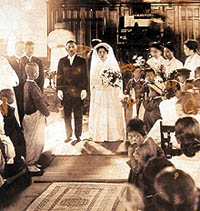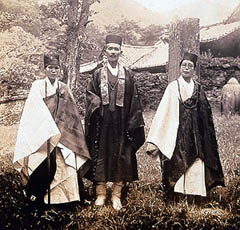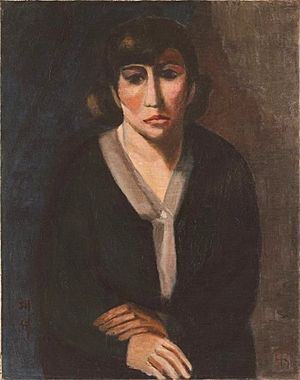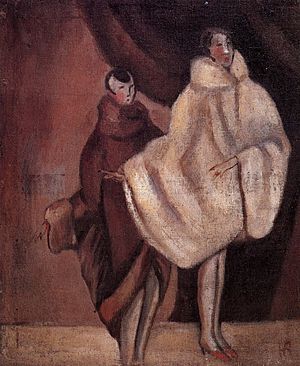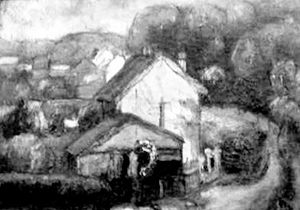Na Hyeseok facts for kids
Quick facts for kids
Na Hye-seok
|
|
|---|---|
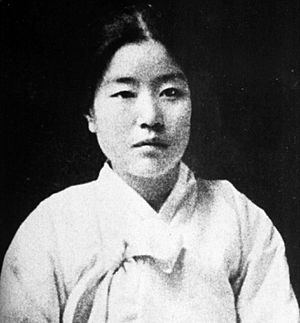
18-19 year-old Na Hye-seok, ca.1915
|
|
| Born | 28 April 1896 Shinpyeong-ri (now Haenggung-dong), Suwon-myeon, Suwon County, Incheon-bu, Joseon |
| Died | 10 December 1948 (aged 52) Wonhyoro il-dong, Yongsan District, Seoul, South Korea |
| Occupation | Poet, journalist, writer, painter |
| Period | 1896–1948 |
| Genre | Poetry, Novel, Art, Painting, Essay, Drama |
| Spouse | Kim Woo-yeong (m.1920; div.1930) |
| Korean name | |
| Hangul | |
| Hanja | |
| Revised Romanization | Na Hyeseok |
| McCune–Reischauer | Na Hye-sŏk |
| Art name | |
| Hangul |
정월
|
| Hanja | |
| Revised Romanization | Jeongwol |
| McCune–Reischauer | Jungwol |
| Courtesy name | |
| Hangul |
명순
|
| Hanja | |
| Revised Romanization | Myungsun |
| McCune–Reischauer | Myungsoon |
Na Hye-seok (Korean: 나혜석; Hanja: 羅蕙錫, 28 April 1896 – 10 December 1948) was a very important Korean feminist, poet, writer, painter, and journalist. Her pen name was Jeongwol (정월, 晶月). She was a pioneer in Korea, meaning she was one of the first to do many things.
Na Hye-seok was the first professional female painter in Korea. She was also the first feminist writer. She created some of the earliest Western-style paintings in Korea. She wrote novels and short stories that supported women's rights. She became famous for speaking out about marriage in the early 1900s.
Contents
Early Life and Education
Na Hye-seok was born in 1896 in Suwon. Her family, the Naju Na clan, was an important aristocratic family. She was the fourth child of Na Gi-jeong and Lady Choi Si-ui.
As a child, she was called Na Ah-ji and Na Myeong-sun. The name Hyeseok was given to her when she started attending Jin Myeong Girl's High School. She showed great artistic talent from a young age. She graduated at the top of her class from Jin Myeong Girl's High School in 1913.
Career and Activism
When she was young, Na Hyeseok was known for being lively and speaking her mind. She clearly stated that she wanted to be a painter and an intellectual. She did not want to follow the traditional role of a "Good Wife, Wise Mother". This traditional role meant a woman should only focus on her home and family.
Her important written work, Kyonghui (Korean: 경희), was published in 1918. This story is about a woman discovering herself. It shows her search for meaning in life as a "new woman." This was the first feminist short story in Korean literature.
After graduating from Jinmyeong Girls' High School in 1913, Na Hyeseok studied Western oil painting. She went to Tokyo Arts College in Japan. As a student, Na wrote many essays that criticized the "good wife, good mother" idea. She said she wanted a career as an artist.
In April 1915, Na helped organize the Association of Korean Women Students in Japan. During this time, she became close with Choe Sung-gu. He was a student at Keio University and edited a magazine called Hakchigwang. Their friendship was well-known among Korean students. In 1915, Na's father wanted her to marry someone from a well-known family. Na avoided this by taking a teaching job at a primary school. After a year of teaching and saving money, Na went back to Tokyo in late 1915 to continue her studies. However, in April 1916, Choe Sung-gu died. Na had to stop her studies for a while to recover.
In 1919, she took part in the March 1st Movement. This was a big protest against Japan's rule over Korea. She was put in jail for this. The lawyer hired by her family to help her later became her husband.
In 1920, Na Hyeseok, along with Kim Iryeop and ten men, started a literary magazine called P-yeho. In the early 1920s, both Kim and Na wrote articles for the first magazine for Korean women, Sinyoja ("New Woman"). They wrote about improving Korean women's clothing. They believed women needed more practical and comfortable clothes. This would help their health and self-image. They spoke against traditional Korean dresses that were not designed for comfort.
On April 10, 1920, Na Hyeseok married Kim Woo-young in Seoul. Their marriage was based on love, which was rare in Korea at that time. On March 18, 1921, Na had her first art exhibition in Seoul. It was the first exhibition by a Korean woman painter ever. In 1923, Na got a lot of attention for her essay "Thoughts on becoming a mother." In it, she criticized her husband for leaving all the child-rearing to her.
In 1927, Na Hyeseok and her husband went on a three-year trip to Europe. This trip was supported by the Japanese government. This made her the first Korean woman to travel to Europe and America. While traveling, Na painted what she saw. She looked closely at European customs, art, and family life. She also explored how women presented themselves. After returning, Na continued to show her art. She held an exhibition in her hometown of Suwon. She displayed art she made in Europe and prints she collected.
Na studied painting in France. Her husband became a Japanese diplomat. Na Hyeseok's husband divorced her in 1931.
Na Hyeseok kept painting and won a special prize at the 10th Joseon Art Exhibition in 1931. She also published a piece called A Divorce Testimony in 1934. In this writing, she talked about gender inequality in Korea. She challenged the old social system where men had all the power.
She passed away on December 10, 1948, at a charity hospital. In her later years, she had no one to care for her. The place where she was buried is still unknown. For a long time, her story was used to warn young Korean women with artistic dreams. People would say, "Do you want to become another Na Hye-sok?" However, she is now recognized in Korea for her amazing art and writing. For example, the Seoul Arts Center held an exhibition of her works in 2000.
Works
- Divorce Testimony (이혼고백서, 離婚告白書)
- Go on a Honeymoon: The Tomb of First Love (첫사랑의 무덤으로 신혼여행을 가다)
- Gyunghee (경희)
- Jeongsun (정순)
- Na Hyeseok jeonjip (나혜석전집, 羅蕙錫全集)
- Na Hyeseok's Collected Works (나혜석 작품집)
- Self-Portrait (자화상), ca. 1928
- Peonies at Hwaryeongjeon (화령전 작약)
- Paris Landscape
- Dancers (ca. 1927-1928)
- Harbor in Spain
- Beach in Spain
- Scene of Paris (1927-1928)
Artwork
Na Hyeseok is mostly remembered for her writings on early feminism. But she also had a big impact on modern Korean art. She created several famous pieces that show her beliefs about gender roles and her life journey. Her most famous work is her Self-Portrait (자화상) from around 1928.
In this oil painting, Na does not look like traditional Korean women. She shows herself as a modern, educated, and independent woman. She wears modern clothes instead of a traditional Korean hanbok. Her hair is also modern, styled in waves with two buns. This was a popular Western hairstyle in the 1920s. Her makeup also looks more Western.
The dark colors in the background blend with her hair and dress. This makes her face stand out. Her carved face, deep eyes, and slightly pressed mouth show tiredness and pain. Her large eyes and high nose bridge look like Western features. The painting shows some influence from Cubism. This might mean she liked the look of Western women. It could also show her wish to understand how women lived in more progressive Western societies. Even though she looks modern and Western, the dark colors in the painting (black, silver, brown) show she was still held back. She lived in a society where old ideas stopped women from making big social changes.
The sad look in her painting shows how hard it was to be a "New Woman" in Korea. Korea in the early 1900s was a very traditional society. Her strong, straight gaze shows her belief in her ideas. She is looking away from the viewer. This might mean that the freedom she wanted for women was not found in her conservative society.
In 2000, the Seoul Arts Center held an exhibition of her works. In 2022, the Los Angeles County Museum of Art (LACMA) showed her self-portrait. It was part of their Korean art exhibition called “The Space Between: The Modern in Korean Art.” BTS’s RM even talked about it in an audio message. This shows how important and respected Na is today for her art.
Another painting by Na Hyeseok is called Dancers (around 1927-1928). It shows two women who appear to be Western. They are wearing brown and white fur coats. Their faces are drawn like those in her self-portrait, with high nose bridges and heavy makeup. This painting suggests luxury and elegance. The women are posed gracefully, showing the fur coats are for style, not just warmth. The title Dancers also suggests this clothing is for beauty. This painting shows Western influence and modernity. The dark colors are similar to her Self-Portrait. This might reflect the challenges she faced and her feelings at the time.
Another artwork by Na Hyeseok is Peonies at Hwaryeongjeon (화령전 작약). Na Hyeseok painted many different subjects. These included farm life, funny scenes, and landscapes. This painting was made after she released A Divorce Confession in 1934. This writing was very controversial. It criticized gender roles and her husband's actions in their marriage. After releasing this work, Na faced many difficulties and became a social outcast. This painting was made just one year later. It shows her hope to be free from social rules.
Na used a painting technique called impasto. This means she used thick paint with visible brushstrokes. This technique helps her show the wind blowing the peonies. The texture and movement in the painting make it feel real. The bright colors (orange, green, yellow, and white) make the painting lively. Both these qualities symbolize the freedom Na wanted as a woman in 20th-century Korea.
Recently, another landscape painting by Na was found. It was at her nephew Na Sanggyun’s house in Seoul. The painting had belonged to the granddaughter of Choi Nam-seon, a famous writer. Choi Nam-seon and Na Hyeseok knew each other from studying in Japan. She gave the drawing to him, and it was kept safe for three generations.
The drawing is thought to be from 1928. This was when Na was in Paris during her 21-month trip around the world with her husband. The painting is 60 centimeters long and 50 centimeters wide. It shows a French village with trees and a red-roofed house. The bold brush strokes make the objects simple but lively. You can also see elements of Fauvism and Expressionism in it.
A professor of Korean modern art, Kim Yi-sun, recognized the artwork. It was from Na's collection book. The painting was confirmed to be hers because of a signature 'HR' on it. She often used this signature in her works.
Other paintings Na might have created in Europe include Harbor in Spain and Beach in Spain. These paintings are different from her Paris landscape. They use bright colors like green, orange, brown, blue, and white. These colors are used in fluid strokes to show details. Interestingly, Na's Scene of Paris (1927-1928), also from this time, uses more muted colors. These colors make the scene look darker and sadder. This artistic choice might suggest that Na felt differently about her time in France compared to other European countries.
Appreciation
Na Hyeseok's novel Gyunghee (경희, 1918) is seen as a work that clearly shows her unique female perspective. Her novels were often like confessions, sharing personal feelings. This style was popular in novels from the 1920s to 1930s.
Works in Translation
- "Kyoung-hee" in Questioning Minds: Short Stories By Modern Korean Writers (p. 24)
Legacy
On April 28, 2019, a Google Doodle celebrated the 123rd anniversary of Na Hyeseok’s birth. This shows her lasting importance.
See also
 In Spanish: Na Hye-sok para niños
In Spanish: Na Hye-sok para niños
- Hwang Jini
- Uhwudong
- Heo Nanseolheon
- Yu Gam-dong
- Im Yunjidang
- Shin Saimdang
- Park Indeok
- Kim Hwallan
- Kim Jong Suk


